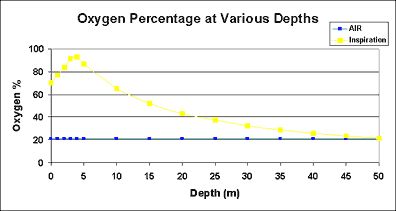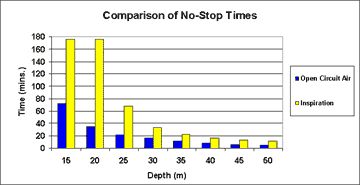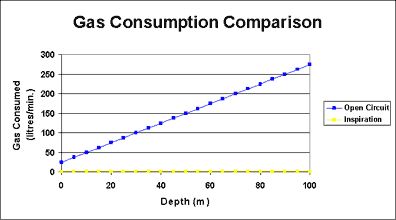
|
One of the big advantages of the Closed Circuit Rebreather (CCR) is that the diver dives with a fixed partial pressure of oxygen. During the dive the fraction of the oxygen content changes with the depth. This principle is exactly the opposite of the Semi-Closed rebreather. The SCR has a fixed fraction and the partial pressure of oxygen changes with the depth. |
|||||||||||||||||||||||||||||||||||||||||||||||||||||||||||||||||||||||||||||||||||||||||||||||||||
|
Example: when a CCR diver has a partial pressure of 1.3 bar O2 (setpoint = 1.3) he will breath at all depth 1.3 bar oxygen. When he dives at 30 meters he will breath a gas with a pressure of 4 bar. If the diluent gas is air the breathed air is 1.3 bar Oxygen and 2.7 bar Nitrogen. Please understand that the oxygen cells in the rebreather measure the oxygen and add pure oxygen until 1.3 bar is reached. The oxygen in the diluent is included in the 1.3 bar! The diver will breath a fraction of (1 : 4,0 bar) x 1,3 bar = 0,325. If the oxygen fraction is 0,325 the diver will breath EAN 32,5. Now at 50 meters (depth limit with air as a diluent) the diver will breather 6bar gas. The mix is then (1:6,0 bar) x 1,3 = 0,216. The diver is breathing EAN 21,6. Here the divers gas is similar to air. Through this calculation we find that the fraction changes and the oxygen content of the gas drops until at 50 meters the breathing gas is similar to air. When we want to go deeper we have to replace a part of the nitrogen by helium. (When diving with air as a diluent a new danger arises because when there is a problem with the oxygen addition is not possible to flush the setpoint down). |
|||||||||||||||||||||||||||||||||||||||||||||||||||||||||||||||||||||||||||||||||||||||||||||||||||
|
A closed circuit rebreather works with set points. Set points are values chosen by the diver. A setpoint is the chosen value for the partial pressure of oxygen. We would like to have a high setpoint as possible, but we are limited due to oxygen toxicity. We now know that in the region of 1,4 - 1,6 bar oxygen pressure, convulsions can occur. For that reason we choose a lower setpoint of 1.3 or 1.2 bar. Most common a setpoint of 1.3 bar pO2 is used. The rebreather will constant inject oxygen until the breathing loop contains 1.3 bar oxygen. This is independent of the diving depth. On the surface however the 1.3 bar will never be reached because the ambient pressure is 1.0 bar. If the setpoint should be set to 1.3 bar on the surface, the rebreather would continuously add oxygen. For that reason there is a low and a high setpoint. The low setpoint usually is set to 0.7 bar. On the surface the low setpoint will cause the loop is injected with oxygen until 0,7 bar is reached. When the diver enter the water he will switch to the higher setpoint below a depth of 3 meter. |
|||||||||||||||||||||||||||||||||||||||||||||||||||||||||||||||||||||||||||||||||||||||||||||||||||
|
Before the dive the rebreather needs to be calibrated. There are different techniques to calibrate a CCR. It is however good practice to calibrate the unit with pure oxygen. If the rebreather is capable of calibrating automatically, usually the mouthpiece is put in the open position, and the computer injects oxygen until there is a stable reading at all 3 cells. This is the reference because the measured voltage form the oxygen cells is relevant for contact with 100% (99,95%) oxygen. High quality systems are also calculating with the ambient pressure because this is another factor to make the calibration more precise. |
|||||||||||||||||||||||||||||||||||||||||||||||||||||||||||||||||||||||||||||||||||||||||||||||||||
|
This diagram shows the fraction oxygen in the breathing air of a closed circuit rebreather versus a open circuit diver. The yellow line shows a decrease in the fraction until 50 meters is reached. Also visible is the switch from low setpoint to high setpoint at 5 meter. |
 |
||||||||||||||||||||||||||||||||||||||||||||||||||||||||||||||||||||||||||||||||||||||||||||||||||
Gas usage:Because this rebreather has a closed cycle the only gas consumed by the diver is oxygen. This consumption is only related to the metabolic use of the diver. The metabolic use is related to the energy the diver uses for swimming or working. Commonly a typical oxygen consumption is 1 - 1.5 ltr per minute. That is the only gas needed by the diver when he swims at the same depth. When he wants to ascent he needs to inject some gas in his dry suit or wing. When he descent he have to add some gas to his counterlung to remain a breathable volume. When compared to a open circuit diver closed circuit diving has a 20 times higher gas efficienty! Most interesting is the fact that the CC rebreather diver uses the same amount of gas at each depth, while the gas consumption of the open circuit diver grows with the depth!
|
|||||||||||||||||||||||||||||||||||||||||||||||||||||||||||||||||||||||||||||||||||||||||||||||||||
|
|
This table shows the gas consumption of a CC diver versus OC diver. The yellow line is drawn at 1 ltr gas consumption per minute. | ||||||||||||||||||||||||||||||||||||||||||||||||||||||||||||||||||||||||||||||||||||||||||||||||||
|
This table shows the advantage is decompression
obligation. If you compare the nitrogen content of the breathing
gas until 50 meters of depth the nitrogen content is much lower
with closed circuit diving. So not only a much lower gas
consumption is realised, it is also possible to stay much longer
down ;) . |
|
||||||||||||||||||||||||||||||||||||||||||||||||||||||||||||||||||||||||||||||||||||||||||||||||||
 |
In this table it is clear that diving the CCR offers the best decompression advantages in the 15-25 meter zone. This fortunately is also the most dived zone when we use the rebreather for recreational dives. When we dive deeper than 50 meter usually Helium is added. So we dive with pure oxygen in one bottle and Trimix in the other bottle. We can dive to depth of 150 + meters and have the advantage of low gas usage en and decompression with high partial pressures of oxygen. |
||||||||||||||||||||||||||||||||||||||||||||||||||||||||||||||||||||||||||||||||||||||||||||||||||
